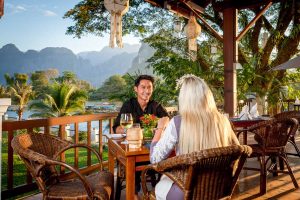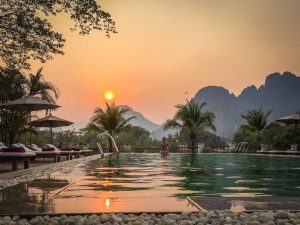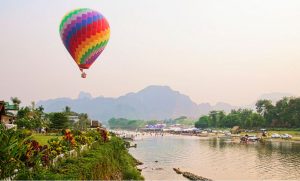ເມື່ອນຶກເຖີງການຂັບລົດໄປທ່ຽວເມືອງວັງວຽງໃນຊ່ວງລະດູຝົນ, ທ່ານກໍຈະມັກພົບກັບທົ່ງນາຂຽວຊຸ່ມຕະການຕາຕັດກັບທັດສະນີຍະພາບທ້ອງຟ້າ ແລະ ພູເຂົາທີ່ຢັງຢາຍສຸດສາຍຕາຕາມທາງເຂົ້າເມືອງວັງວຽງທີ່ເປັນທາງຄົດໂຄ້ງ ອ້ອມຮອບດ້ວຍເຫຼົ່າພູຜາຫີນປູນຍາວຢຽດໄປຈົນສຸດຕົວເມືອງວັງວຽງ.
ການຫາໂອກາດໄປພັກຜ່ອນເມືອງວັງວຽງແມ່ນໃຊ້ເວລາບໍ່ດົນເລີຍ, ແລະ ທີ່ພັກກໍມີຫລາຍຮູບແບບໃຫ້ເລືອກ ຣີເວີຊາຍ ບູຕິກ ຣີສອດ ເປັນທາງເລືອກຂອງສະຫວັນແຫ່ງການພັກຜ່ອນເພື່ອຜ່ອນຄາຍຈາກວຽກງານຕ່າງໆທີ່ທ່ານຕ້ອງຫາໂອກາດມາໃຫ້ໄດ້ ຣີສອດແຫ່ງນີ້ແມ່ນຕັ້ງຢູ່ຫ່າງຈາກຕົວເມືອງວັງວຽງພຽງເລັກນ້ອຍ, ອ້ອມຮອບຣີສອດທ່ານຈະໄດ້ພົບເຫັນກັບພາບຂອງການຫາປາແຄມນໍ້າຊອງ ແລະ ທິວທັດຂອງພູເຂົາສີຂຽວສະລັບຊັບຊ້ອນຕັດກັບທ້ອງຟ້າສີຫມອກໄດ້ຈາກລະບຽງຫ້ອງນອນ, ແນມລົງມາຈະເຫັນພະນັກງານກຳລັງເກັບມ້ຽນຜ້າຢາງກັນຝົນ ພ້ອມກັບກຳລັງແຈກຢາຍຜ້າເຊັດໂຕ ເທີງຕັ່ງນອນຂອງເບາະອັນແສນນຸ້ມຢູ່ອ້ອມຂ້າງສະນໍ້າທີ່ແສງແດດກະທົບກັບຜິວນໍ້າເກີດປະກາຍຍິບຍັບ ເມື່ອຝົນຊາລົງ ພຽງເທົ່ານີ້ທ່ານກໍພ້ອມທີ່ຈະຈຸ່ມໂຕລົງສະນໍ້າ ນັ່ງຈິບເຄື່ອງດື່ມເບົາໆໄປກັບການພັກຜ່ອນຍ່ອນໃຈທີ່ດີທີ່ສຸດ.


ໃນ 10 ປີກ່ອນ, ວັງວຽງຍັງບໍ່ເປັນທີ່ຮູ້ຈັກຫລາຍ.ນັກທ່ອງທ່ຽວຫລັກ ແມ່ນນັກທ່ອງທ່ຽວແບກເປ້ ຖະຫນົນຫົນທາງກໍຍັງສັນຈອນບໍ່ສະດວກ ໂດຍສະເພາະຍາມຝົນ. ຮ້ານຂາຍເຄື່ອງເຕັມສອງຂ້າງທາງຖະຫນົນສາຍຫລັກ, ບົດບັງພາບທຳມະຊາດຂອງເມືອງວັງວຽງ.
ເຖີງຢ່າງໃດກໍຕາມໃນຊ່ວງຫລັງມານີ້, ຫລາຍຢ່າງໃນເມືອງວັງວຽງໄດ້ປ່ຽນແປງໄປໃນທາງທີ່ດີຂື້ນ. ປັດຈຸບັນເມືອງວັງວຽງປຽບເຫມືອນຄື້ນແມ່ເຫລັກທີ່ດຶງດູດເອົານັກທ່ອງທ່ຽວໄວຫນຸ່ມທີ່ສະແຫວງຫາສະຖານທີ່ສັງສັນໃນລາຄາທີ່ຈັບຕ້ອງໄດ້ ຈົນເຮັດໃຫ້ຖະຫນົນເສັ້ນນ້ອຍຂອງເມືອງດັ່ງກ່າວອັດແຫນ້ນໄປດ້ວຍນັກທ່ອງທ່ຽວຊາວເອີຣົບ ແລະ ອົດສະຕາລີ.
ແຕ່ຕອນນີ້, ກຸ່ມນັກທ່ອງທ່ຽວຫຼັກກຳລັງປ່ຽນແປງໄປເປັນນັກທ່ອງທ່ຽວຊາວອາຊີຫລາຍຂື້ນ, ໂດຍສະເພາະແມ່ນນັກທ່ອງທ່ຽວຈາກປະເທດເກົາຫລີ ກວມເອົາເຄີ່ງຫນື່ງຂອງນັກທ່ອງທ່ຽວທັງຫມົດ. ຕ້ອງຂອບໃຈລາຍການໂທລະພາບຂອງເກົາຫລີ “Youth Over Flower” ເຊີ່ງມີຕອນຫນື່ງທີ່ໄດ້ມາຖ່າຍທຳລາຍການທີ່ເມືອງວັງວຽງໃນປີ 2014. ເຮັດໃຫ້ມີນັກທ່ອງທ່ຽວຈາກປະເທດເກົາຫລີຫລັ່ງໄຫລເຂົ້າມາທ່ອງທ່ຽວໃນລາວເລື້ອຍໆ. ນັກທ່ອງທ່ຽວທີ່ມາຢ້ຽມຢາມຕ່າງກໍເຄົາລົບ ແລະ ມັກຮັກໃນທໍາມະຊາດເມືອງວັງວຽງ.
ນອກຈາກນັ້ນ, ຍັງມີຫຼາຍສະຖານທີ່ທ່ຽວຊົມສຳຫຼັບຄົນທີ່ບໍ່ມັກການສັງສັນ, ຫ່າງອອກໄປຈາກຕົວເມືອງປະມານຫ້ານາທີຈະມີໝູ່ບ້ານທີ່ສວຍງາມ, ຖໍ້າໃຫ້ທ່ານໄປຄົ້ນຫາ, ປະສົບການໃນສວນພືດ, ແລະ ບຶງນໍ້າສີຟ້າທີ່ໂດ່ງດັງ ເຊິ່ງເປັນເຫດຜົນທີ່ແທ້ຈິງຂອງການທ່ຽວວັງວຽງ.



ດ້ວຍນັກທ່ອງທ່ຽວເກົາຫລີທີ່ລັ່ງໄຫລເຂົ້າມາບໍ່ຢຸດເຮັດໃຫ້ ຣີເວີຊາຍ ບູຕິກ ຣີສອດ ສາມາດດຳເນີນທຸລະກິດໄດ້ໂດຍບໍ່ມີ Low Season ເລີຍ. ຍີ່ງໄປກວ່ານັ້ນ ຣີສອດເອງກໍເກືອບຖືວ່າບໍ່ມີຄູ່ແຂ່ງໃນລະດັບຫລູຫລາເທົ່າກັນເລີຍ ເພາະວ່າທີ່ພັກສ່ວນຫລາຍໃນເມືອງວັງວຽງແມ່ນທີ່ພັກທຳມະດາທົ່ວໄປ. ເຖິງແມ່ນວ່າຝົນຈະຕົກໜັກໃນບາງຊ່ວງ ແຕ່ກໍຖືໄດ້ວ່າ ຣີສອດ ດັ່ງກ່າວແມ່ນຄັບແໝ້ນໄປດ້ວຍຜູ້ມາພັກອາໃສຈົນເຮັດໃຫ້ຫ້ອງເກືອບເຕັມຢູ່ຕະຫຼອດເວລາ, ທັງນີ້ ກໍລວມໄປເຖິງຮ້ານອາຫານທີ່ຖືວ່າເປັນໜຶ່ງດຽວໃນເມືອງທີ່ເນັ້ນດ້ານຄຸນນະພາບ ແລະ ລົດຊາດຂອງອາຫານໃຫ້ທຽບເທົ່າກັບສາກົນ.
ທ່ານ ສະເຕຟານ ວິຊີເອ ຮູ້ນສ່ວນຂອງຣີສອດໄດ້ຄາດຫວັງວ່າ ຈະມີນັກທ່ອງທ່ຽວລະດັບສູງເຂົ້າມາຫຼາຍຂຶ້ນ. ທັງນີ້ຕົວເມືອງວັງວຽງກໍຕ້ອງມີການປັບປຸງໂຄງສ້າງເມືອງ ແລະ ມີການຄຸ້ມຄອງຮັກສາສິ່ງແວດລ້ອມຫຼາຍຂຶ້ນ.
ທ່ານໄດ້ກ່າວວ່າວ່າ: “ຕ້ອງເນັ້ນຫນັກການຈັດສັນຕົວເມືອງໃຫ້ຫຼາຍຂຶ້ນ, ພ້ອມກັນນັ້ນກໍຕ້ອງມີການຍົກລະດັບມາດຕະຖານການບໍລິການ ແລະ ເປີດຮ້ານອາຫານທີ່ມີຄຸນນະພາບໃຫ້ຫລາຍຂື້ນ
ພາຍນອກຕົວເມືອງທີ່ມີທຳມະຊາດສວຍງາມກໍຢາກໃຫ້ມີການຄຸມເຂັ້ມລະບົບການຟື້ນຟູຮັກສາ ແລະການພັດທະນາກົນໄກໃນການເຮັດກິດຈະກຳຂອງນັກທ່ອງທ່ຽວ ເພື່ອບໍ່ໃຫ້ມີຜົນກະທົບຕໍ່ຊັບພະຍາກອນທຳມະຊາດອັນເປັນຊັບສິນຂອງເມືອງວັງວຽງຢ່າງແທ້ຈິງ.
ຢູ່ພາຍໃນຣີສອດຂອງເຮົາ, ເຮົາກໍພະຍາຍາມເປັນຕົວຢ່າງ ແລະ ສົ່ງເສີມການທ່ອງທ່ຽວທີ່ບໍ່ເປັນໄພຕໍ່ລະບົບນິເວດ ກໍຄືເນັ້ນໜັກສົ່ງເສີມວັດທະນະທໍາທ້ອງຖິ່ນອັນເປັນມໍລະດົກຂອງເມືອງວັງວຽງ ແຕ່ມັນກໍບໍ່ອາດຄືບໜ້າໄດ້ຫຼາຍຖ້າເຮັດຜູ້ດຽວ”
ພວກເຮົາຢູ່ທີ່ນີ້, ຢູ່ຫ່າງໄກຈາກຕົວເມືອງທີ່ແອອັດ ເປັນດັ່ງເພັດໃນກອງເມັດຊາຍທີ່ຍາກທີ່ຈະລືມ.



 English
English
